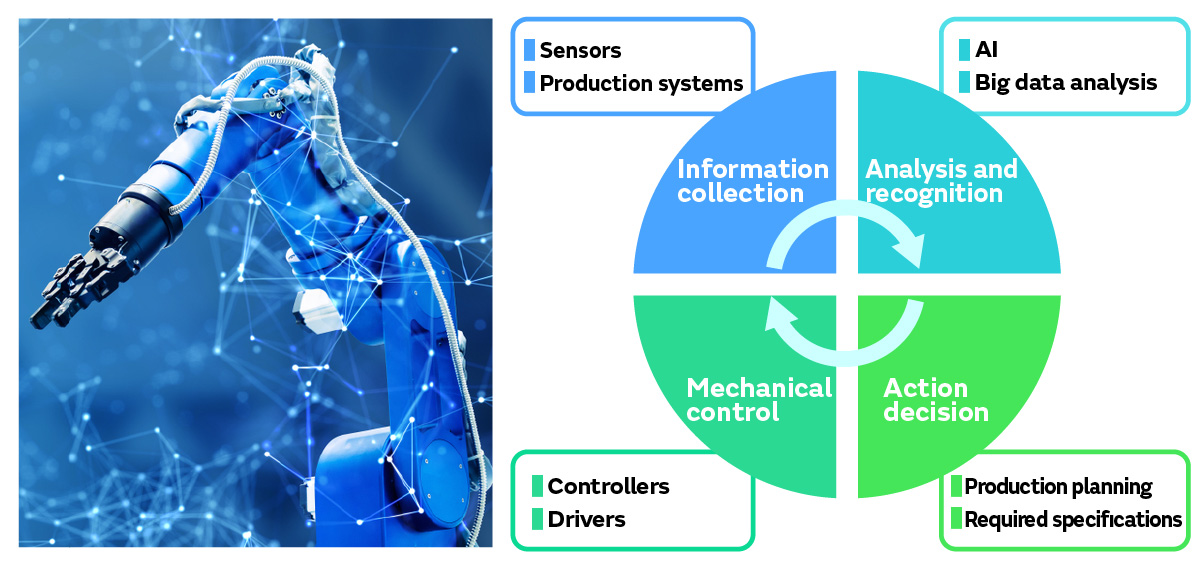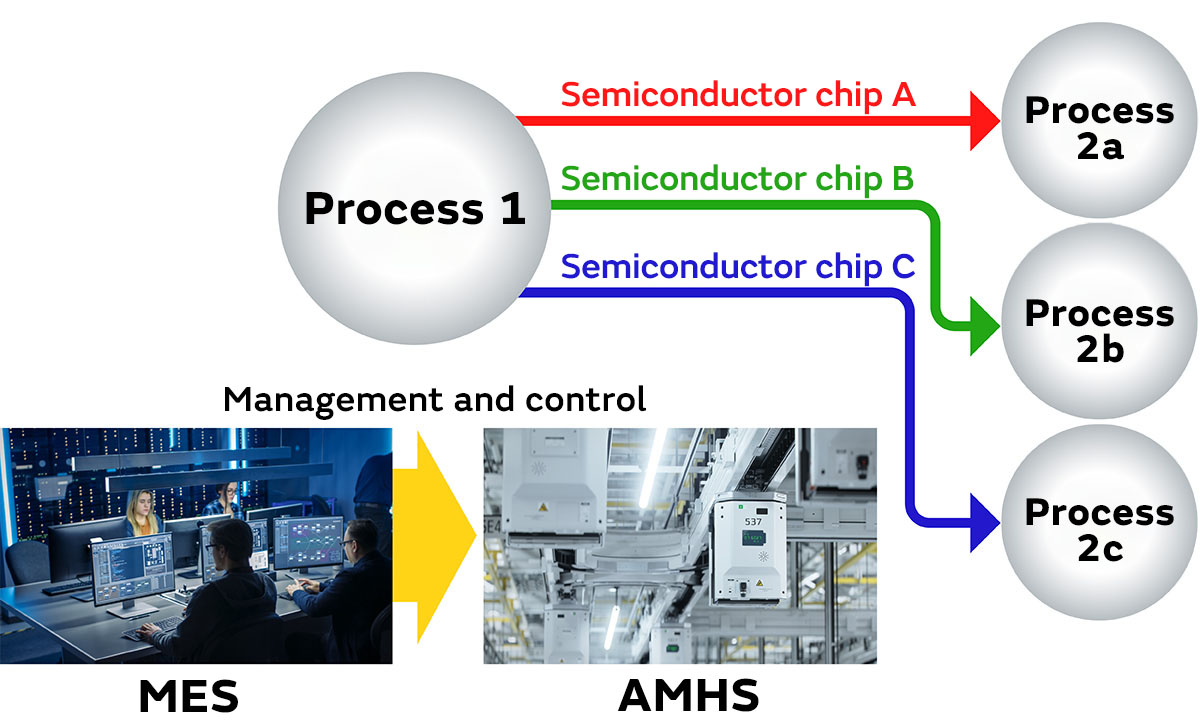Views: 0 Author: Site Editor Publish Time: 2025-07-15 Origin: Site

From Automation To Autonomy, Coordination, And More Intelligent Production Robots
Smart factories that make manufacturing DX a reality,Intelligent factory,Robot,DX,Internet of Things,AI,Sensor
Ovens that can cook according to the quantity and condition of ingredients, as well as algorithmic trading that can accurately determine the timing of stock buying and selling based on market changes, and so on... . In recent years, such devices and systems that operate intelligently based on data have been widely utilized. Among them, some devices can make highly accurate judgments on par with those of humans, and in some application methods, there have even emerged devices that surpass human working capabilities.
An intelligent robot that can flexibly complete tasks by using sensors and AI
In the past, household appliances and information systems could only strictly complete various tasks in accordance with the pre-determined sequence and conditions. Its advantage is that it will not perform operations beyond the preset even when the usage environment changes, but at the same time, it also has the problem of being unable to adapt flexibly to circumstances. Of course, even such previous devices have the advantage of being able to work quickly and accurately automatically, and can be said to have played a sufficient role in many aspects.
Recently, intelligent devices and systems can respond flexibly on their own, and their application scope has expanded to work fields that have hitherto relied on human hands. The effect of such intelligent devices and systems is particularly remarkable in the manufacturing industry. They can sense the individual differences of workpieces and the fluctuations in operation quality during production, and independently adjust production conditions, thereby achieving intelligent factories that can maintain work efficiency and quality at a high level.

This trend of intelligence is particularly prominent in the field of industrial robots. So far, industrial robots have mainly been used to automate monotonous and repetitive tasks as well as those that are dangerous and arduous for humans. However, due to the lack of operational flexibility like many previous devices, its application scope is also very limited. Today, industrial robots are capable of performing various tasks that previously had to be carried out by hand due to the need for flexibility.
Internal image processing of intelligent robots that can flexibly respond based on data
Figure 1 shows the internal processing of an intelligent robot that can respond flexibly based on data
In recent years, intelligent robots have made remarkable progress, capable of continuously performing four tasks internally: "information collection", "analysis and recognition", "action decision-making", and "mechanism control" (Figure 1).
Among them, during the process of information collection, data of the surrounding environment and even information of the production system are generally collected through cameras, sensors, etc. During the process of analysis and recognition, based on the collected data, advanced information processing technologies such as artificial intelligence (AI) are utilized to make status judgments. In other words, it can be said that intelligent robots are a kind of high-end IoT system. In the next step, that is, the process of making action decisions, it is necessary to determine under what conditions the robot should be operated in order to achieve the goal. After this stage, if the required actions can be correctly determined based on the collected information, there will be no significant difference from the previous FA technology used to control industrial robots. In addition, it is necessary to control the motors of the movable parts such as the mechanical arm and mechanical hand that drive the robot through mechanism control.
In semiconductor factories, robots are autonomously controlled through linkage with the production management system
Today, what kind of work do intelligent robots undertake in advanced factories and what kind of effects do they bring? The following will take semiconductor factories and automotive factories, that is, two types of advanced factories with completely different job requirements within the factory, as examples for introduction.
First is the semiconductor factory. In semiconductor factories, various processing and treatments are carried out on silicon wafers to produce chip products with fine and complex circuit diagrams. The characteristic of a semiconductor factory is that it has pushed the automation and labor-saving of processes and operations on the production line to the limit. The purpose of doing this is that if people are allowed to enter the factory, then the people themselves will become the main cause of reducing the yield of chips.

In recent years, in the semiconductor industry, with the development of horizontal division of labor in design and manufacturing, product manufacturing is often entrusted to enterprises capable of producing various types of chips. Such enterprises are called foundries. In foundries, the types of chip manufacturing can be adjusted according to market demand and the production plans of professional manufacturers, which is known as variant variable production. At the same time, as the processing and handling sequence and conditions for each type of chip manufacturing may vary, frequent changes in steps or transportation destinations between devices often occur within the factory. Therefore, it is necessary to introduce a mechanism that can flexibly respond to changes in production varieties by minimizing human intervention and relying solely on machines and systems.
Under the management and control of MES, pictures are conveyed to the processes that conform to each chip manufacturing procedure
Figure 2 shows the delivery to the processes that conform to each chip manufacturing flow under the management and control of MES
It is precisely intelligent robots that meet such requirements. In the handling between different processes within a semiconductor factory, a handling robot known as AMHS*1 (Figure 2) has come into its own. To maximize the production efficiency of semiconductor factories, a mechanism for timely material handling based on the production schedule and the progress of each process is indispensable. Therefore, the actions of the AMHS used in the handling between different processes are linked with the MES*2 that manages the processing and conditions of each process, handling, etc. Through autonomous control, it enables the handling operation to be carried out at the ideal time.
Amhs stands for Automated MaterialHandling Systems, which is translated as automatic material handling system and is a type of AGV (Unmanned Delivery Vehicle). Generally speaking, this system can lift the boxes that hold FOUPs, or single batches of wafers, along the tracks set on the factory ceiling and transport them to the destination.
Mes is the abbreviation of Manufacturing Execution System, which is translated as Manufacturing Execution System. It is an information system that can visualize the status and actions of devices and processing and handling objects on the production line, provide assistance to operators and offer decision support. In semiconductor factories, in many cases, the action conditions of robots and devices are adjusted and controlled independently by information systems without human judgment.
In an automobile factory, humans and robots coordinate to complete assembly and inspection processes
Now let's take a look at the situation of the car factory. It is said that currently each car consists of approximately 30,000 components. In the vehicle manufacturing plant, through five processes including "pressing", "welding", "spraying", "assembly" and "inspection", a wide variety of components and materials are assembled in a complex and accurate manner to complete the production of vehicles, and each process utilizes various types of robots.
Among the five processes, three - pressing, welding and spraying - have achieved labor-saving operations, just like in semiconductor factories. The reason lies in the fact that the materials used in work are often very heavy or may cause harm to people from harmful gases and drugs. Therefore, in these processes, large and agile multi-axis robots and the like are often used. For such robots, the requirements for their working speed and accuracy are higher, often exceeding those for intelligence.
In the assembly and inspection processes of an automobile factory, collaborative robots that can work in coordination with humans have shown their prowess
Figure 3 shows that in the assembly and inspection processes of an automobile factory, collaborative robots capable of coordinating with humans are fully demonstrated
On the other hand, in the assembly and inspection processes, although robot technology has advanced to a high degree at present, there are still some operations that must rely on human hands. This is because some of these tasks require precise adjustment of part positions, precise force during installation, or must rely on human sensibility for inspection, etc. However, since not all operations rely on manual labor, in order to enhance operational efficiency and quality, it is also necessary to further improve the automation level of robots. Moreover, here, robots that can coexist with humans and coordinate their work are often utilized. We call them collaborative robots *3 (Figure 3).
Collaborative robots refer to those equipped with robots that ensure safety performance. It can coexist with people at the same work site and perform interlinked operations without the need to prepare safety barriers.
In recent years, the progress of collaborative robots has been very remarkable. At present, some robots have been equipped with the function of being able to monitor the operation progress of nearby staff and coordinate smoothly. When manual operation is adopted, each person's proficiency in work, physical condition and fatigue level may all become factors affecting work efficiency. Therefore, in order to enhance the operational efficiency within the process, it is necessary to coordinate the movements of the robots working together to keep them in sync with the human operations.
We predict that the robots active in factories will surely become increasingly intelligent in the future. Its development mainly benefits from several aspects, including sensor technology for data collection, industrial network technology capable of information sharing between devices and equipment, and even the progress of advanced information processing technologies such as AI. The importance of electronic components and semiconductors for intelligent robots will surely increase day by day in the future.